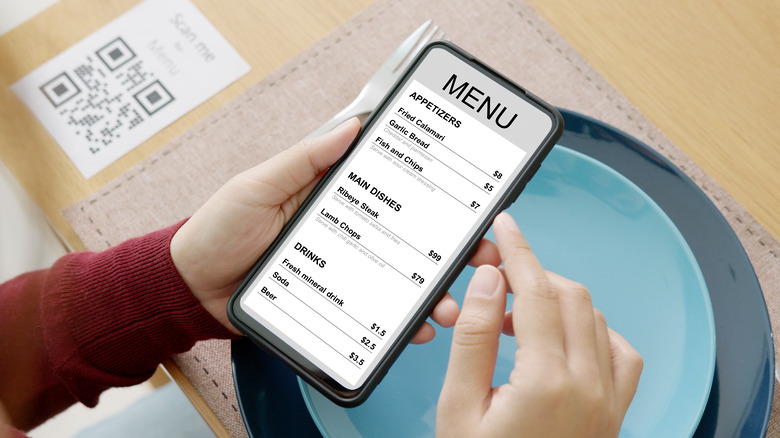You're Not Imagining It. Restaurant Menus Have Been Getting Smaller
Cast your memory back, if you will, to the dark days of 2020 when "dining out" consisted of calling DoorDash or Grubhub and then paying exorbitant delivery fees — in some cases, only to find out that those "local" restaurants you were trying to support were really just Chuck E. Cheese or Applebee's in disguise. Wasn't it exciting when restaurants finally opened their doors again and let us actually eat off plates we didn't have to wash with a view of something other than our own TVs?
Disenchantment soon set in, however, when we revisited some of our old favorites, only to find that those dishes we'd been craving had mysteriously vanished from the menu. Were our memories playing tricks on us, or had the menus somehow ... shrunk? Nope, not your imagination. Restaurant menus are a lot shorter these days, and it looks like you'd better learn to live with it (via MSN). While these changes may not be popular with diners, they are most likely benefiting the restaurant owners.
The pandemic is to blame for menu cuts
There are a number of reasons why restaurants have adopted shorter menus over the past year or so. One of the first to do so, or at least the first to announce it, was McDonald's. The chain drastically reduced its menu early in the pandemic in order to operate more efficiently at a time when takeout orders were ramping up and the workforce was shrinking, per Inc. Some of these cuts allowed its restaurants to eliminate less profitable items (such as all-day breakfast), so McDonald's franchise owners embraced the changes and wanted to make them permanent. IHOP reduced its own offerings upon re-opening in order to replace its potentially-germy laminated menus with disposable paper ones.
Well, even in 2021, labor shortages are still affecting restaurants' ability to serve their patrons, as evidenced by fast food chains offering an unprecedented level of benefits to hourly employees and even trying to tempt potential interviewees with freebies. Higher up the restaurant food chain, things are still pretty dire. As one North Carolina restaurateur told Food & Wine, '"Even just one less cook at night eliminates an entire station." Supply chain issues, as well as the rising prices of food, also mean that many restaurants are either unable to source needed ingredients or else simply cannot afford to use them in their cooking at this time.
Shorter menus may well be a good thing for restaurants
Even if the labor and supply shortages miraculously resolve themselves by the end of 2021, don't expect restaurant menus to go back to what they were in pre-pandemic days. Some restaurants may eventually restore their 2019 offerings, but others may well choose to stick with the shorter, simpler menus. After all, they've successfully managed our expectations downwards, so why make changes when they don't have to?
Some chefs such as Marcus Samuelsson are spinning these shorter menus as a good thing for all of us. As he said to Food & Wine, "Smaller menus mean more focus ... this is a time when we will see American food through a different lens." Others, however, are getting down to the blunt truth of the matter. As Washington D.C. restaurant owner Amy Brandwein admits, "Smaller menus mean more efficiency, less waste and more operating income for the owners." So yes, get used to those shorter menus. It seems like those are going to be part of the "new normal," not just for the foreseeable future, but quite possibly on a permanent basis.


